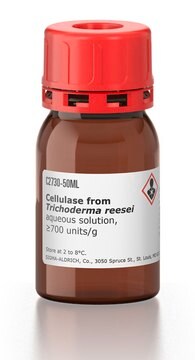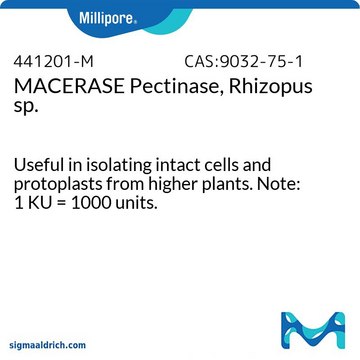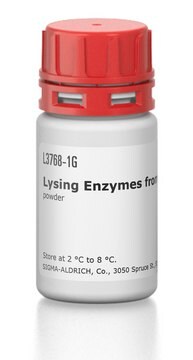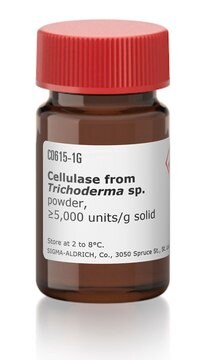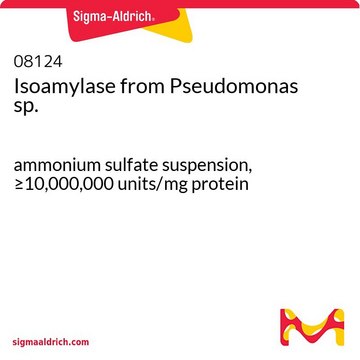17389
Pectinase from Aspergillus niger
powder, slightly beige, >1 U/mg
Synonyme(s) :
Polygalacturonase
Se connecterpour consulter vos tarifs contractuels et ceux de votre entreprise/organisme
About This Item
Produits recommandés
Source biologique
Aspergillus niger
Forme
powder
Activité spécifique
>1 U/mg
Couleur
slightly beige
Température de stockage
2-8°C
Vous recherchez des produits similaires ? Visite Guide de comparaison des produits
Description générale
Pectinase, also known as pectinolytic enzyme, is predominantly found in bacteria, fungi and plants. polygalacturonase is a highly found enzyme among all the pectinolytic enzymes.
Application
Pectinase from Aspergillus niger has been used to hydrolyze pectin layers in
- activated sludge flocs
- bamboo powder for degumming process
- garden cress (Lepidium sativum) seeds to enhance testa permeability, visualized using tetrazolium staining solution
Actions biochimiques/physiologiques
Pectinase found in plants aids in cell wall extension and softening of some plant tissues during maturation and storage. Polygalacturonase is the enzyme that catalyzes the hydrolysis of the polygalacturonic acid chain by addition of water. Pectinase has wide range of industrial applications including, fruit juice extraction and its clarification, scouring of cotton, degumming of plant fibers and waste water treatment. In addition, it is also used in vegetable oil extraction, tea and coffee fermentations, bleaching of paper, in poultry feed additives and in alcoholic beverages and food industries.
Définition de l'unité
1 U entspricht der Enzymmenge, die 1 μmol Galacturonsäure aus Polygalacturonsäure pro Minute bei pH 4.1 und 50°C freisetzt
Mention d'avertissement
Danger
Mentions de danger
Conseils de prudence
Classification des risques
Resp. Sens. 1
Code de la classe de stockage
11 - Combustible Solids
Classe de danger pour l'eau (WGK)
WGK 3
Point d'éclair (°F)
Not applicable
Point d'éclair (°C)
Not applicable
Équipement de protection individuelle
Eyeshields, Gloves, type N95 (US)
Faites votre choix parmi les versions les plus récentes :
Déjà en possession de ce produit ?
Retrouvez la documentation relative aux produits que vous avez récemment achetés dans la Bibliothèque de documents.
Les clients ont également consulté
Bamboo fibre processing: insights into hemicellulase and cellulase substrate accessibility
Fu Jiajia, et al.
Biocatalysis and Biotransformation, 30(1), 27-37 (2012)
Microbial pectinolytic enzymes: a review
Jayani RS, et al.
Process Biochemistry (Oxford, United Kingdom), 40(9), 2931-2944 (2005)
Li-Hung Chen et al.
Science advances, 7(19) (2021-05-09)
Effectors are small, secreted proteins that promote pathogen virulence. Although key to microbial infections, unlocking the intrinsic function of effectors remains a challenge. We have previously shown that members of the fungal Avr4 effector family use a carbohydrate-binding module of
Aránzazu Manzano et al.
American journal of botany, 108(9), 1775-1792 (2021-09-16)
Light and gravity are fundamental cues for plant development. Our understanding of the effects of light stimuli on plants in space, without gravity, is key to providing conditions for plants to acclimate to the environment. Here we tested the hypothesis
Eman Ibrahim et al.
Journal of biochemistry, 169(1), 109-117 (2020-08-19)
Lignocellulosic biomass conversion using cellulases/polygalacturonases is a process that can be progressively influenced by several determinants involved in cellulose microfibril degradation. This article focuses on the kinetics and thermodynamics of thermal inactivation of recombinant Escherichia coli cellulases, cel12B, cel8C and
Notre équipe de scientifiques dispose d'une expérience dans tous les secteurs de la recherche, notamment en sciences de la vie, science des matériaux, synthèse chimique, chromatographie, analyse et dans de nombreux autres domaines..
Contacter notre Service technique


